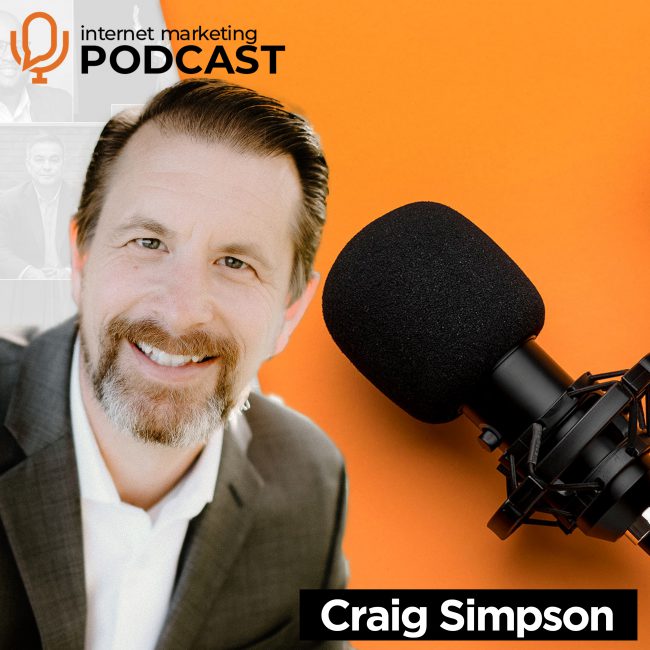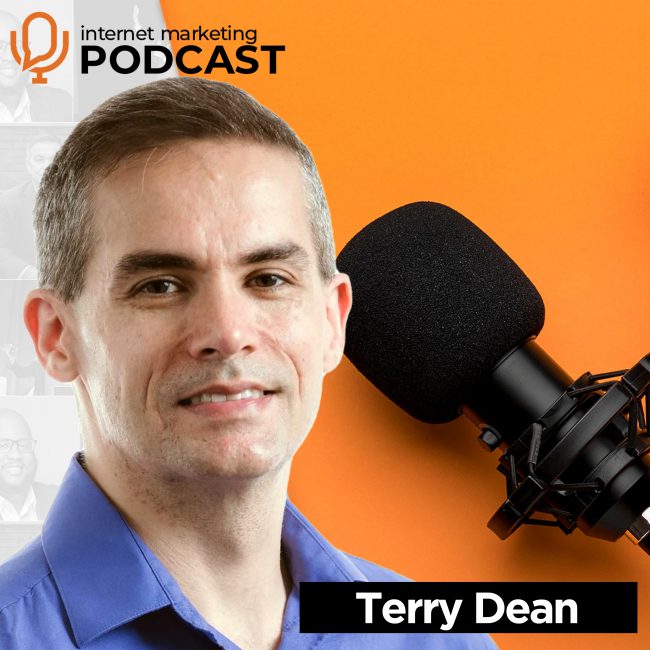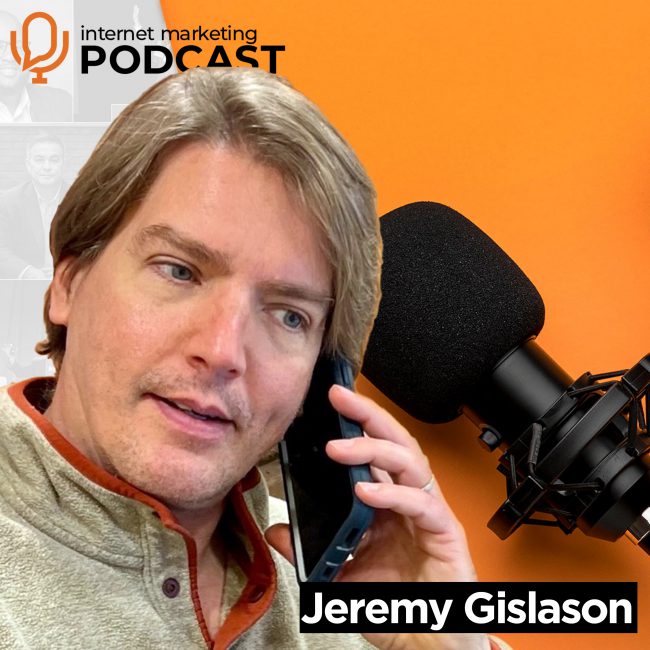
About this Podcast:
Today, we’re chatting with a true expert in direct marketing. He’s been trained alongside some of the biggest names in marketing. People like Bill Glazer and Dan Kennedy. And now, he stands shoulder to shoulder with those guys.
In the last few years, Craig Simpson has sent over 300 million pieces of direct mail, and he’s been able to analyse what works and what doesn’t work. And that’s why I’m really excited about chatting to Craig today. We’ll also find out about how direct marketing stacks up against email marketing, or advertising online, with sites such as YouTube and Google.
Episode Transcript:
Editor:
Today, we're chatting with a true expert in direct marketing. He's been trained alongside some of the biggest names in marketing. People like Bill Glazer and Dan Kennedy. And now, he stands shoulder to shoulder with those guys. In the last few years, Craig Simpson has sent over 300 million pieces of direct mail, and he's been able to analyse what works and what doesn't work. And that's why I'm really excited about chatting to Craig today. We'll also find out about how direct marketing stacks up against email marketing, or advertising online, with sites such as YouTube and Google. Craig, it's lovely to meet you.Craig Simpson:
Thank you. I'm glad to be with you and chat with you today.Editor:
Well, let me start by asking a little bit more about you and your background, and how you got started.Craig Simpson:
Yeah. So, I got started in direct mail marketing in a really unique way. The first thing I actually sold through the mail was fake rock climbing holds. I had built this climbing wall in my backyard and I wanted to bolt on these holds, but I didn't have any money for them. And so, I ended up making these fake rock climbing holds on my own. And everyone loved them. They said, "You should start selling them." So, I did my first mail campaign, which was a complete flop. Nobody responded.Editor:
Right.Craig Simpson:
But I kept trying and testing. And I eventually sold over 4,000 rocks, fake rocks, through the mail, for the rock climbing industry. And that got my start into direct mail marketing.Editor:
Wow. So, did you have a full-time job at the time?Craig Simpson:
Well, I was just out of high school. I was only 19 years old. I think I was working at a gas station, or something, on the side.Editor:
Right.Craig Simpson:
And I was an entrepreneur. I got started real early ended out, and it turned into a full business. And it led me into direct mail marketing for a big publishing industry and everything else. But that was my start, selling fake rocks through the mail.Editor:
That's amazing. What a way to get started. And did you get great feedback about your fake rocks?Craig Simpson:
Well, my first mailing was complete bomb. I got zero calls, zero orders. But I learned some things, and I tweaked and I changed. And eventually, obviously, became a success because I sold thousands of them. But there was a lot that I learned in every campaign, and I didn't know anything. I just knew back then that, I had heard direct mail worked, and so I just had to start tweaking and testing things until I found something that worked well.Editor:
Got you. And for anyone who's unfamiliar with the term direct marketing, could you just maybe explain what it is and how it works?Craig Simpson:
Sure. So, direct marketing is basically sending out an advertising message to somebody and then asking them to respond. And when they respond, that's kind of that engagement. There's a lot of marketing, say, like a billboard, where it's just promoting something. And you look at the billboard, you remember the name on the billboard, but it's not asking you to take the next step. Direct marketing, we're asking the prospects to do something, to call, to go online, to make some kind of commitment by responding. And that's what we consider direct marketing.Editor:
Got you. Because I think people may be familiar with the term CTA, so Call to Action, I guess this is that, but on steroids, right?Craig Simpson:
Yes, yes, exactly.Editor:
And is it true that direct marketing is one of the best ways to get traffic to a website?Craig Simpson:
It is. So, what I specialise in is direct mail, direct marketing, and that's sending things through the physical mailbox. And what I love about it, it's the one media where the prospect has a physical thing in their hand that they're forced to do something with. So, we show up in their mailbox and they take it to their counter or their coffee table or their desk, and they have to decide whether to keep it, read it, toss it, whatever they want to do. But it forces them to make a decision. Whereas with email or TV or radio, you can push a button and those ads disappear. They're gone instantly. It's easy to get rid of them. With the mail, they physically have to do something with it, and that's what I love about it. So, when it comes to, hey, even though it's this physical piece, we can drive people to an online website to register for something, to go get more information. And it's a great tool for driving people online.Editor:
Absolutely. I think a lot of people shy away from direct mail because of course it does have a cost associated with it, whereas a lot of people think that emailing is free. Maybe they're mistaken in that belief, but what are your thoughts on that, Craig?Craig Simpson:
Yeah. There is a cost to direct mail marketing. It's not something where you can just quickly test something and hope it works, because there's all this cost involved. I mean, there's postage and there's printing, and there's lists, and there's all these things that go into it. So, you really have to strategize and come up with your best message, and solution, and offer you can, it's not something you just want to do halfway. You've got to be all in with it. You've really got to make sure your I's are dotted and your T's are crossed.Editor:
Absolutely. And I guess, when people look at the ease of sending an email, as you say, with direct mail, you have to write the copy, pay for the postage. And in many ways, people start by perhaps even putting the copy into the envelopes themselves, sticking a stamp on the envelope and sending it. So, I guess, there's more of a barrier to entry. But the results can far outweigh the effectiveness of email. Is that what you found in your experience?Craig Simpson:
Yeah. Let's think about this. So, if you were to take a step back and look at how many emails you receive every day, it may be a hundred. Some people, it may be more. Some people, it may be a little bit less, but that's a lot of emails to wade through every day. With direct mail, think about how many personal letters you get in the mail every day. If you can make your letter or your piece look like an invitation or a letter, you don't make it look like a sales thing piece necessarily. If you have something that you can put in the mailbox that looks different, and we're only talking about a few pieces of mail in there. Maybe you have 10 other things in there, maybe it's five, you have a better opportunity to grab the prospect's attention. There's less traffic around it, right? There's not as much business you're competing with because your mailbox is empty, and then you've got that whole physical touch thing again. So, it does take a lot more effort to get into the mail, but the response usually outweighs that, because you don't have the competition that you do, say, in the email inbox.Editor:
Absolutely. And you mentioned before about lists. Of course, that's a big question that people have, which is, I don't have a list, so how can I send direct mail marketing without a list? Maybe, again, you could just explain about how you overcome that particular hurdle.Craig Simpson:
Sure. Yeah. So if you don't have your own list, which a lot of businesses don't, there's a couple different ways, and it all depends on who you're marketing to. Let's say you have a joint cream that helps out with aches and pains in your joints, and you want to sell your product to consumers who buy that kind of thing. Well, there are list brokers out there who will help you find those lists, and then you're able to rent them. And then you can rent those names, basically physical names and addresses, that you can mail your offer to, promoting, say, joint cream. And in that case, we'd want to find people who have bought similar products or services. Because if they've already bought something from someone else, there's a good chance that that's something they're interested in. It's a need or a desire. And so, if you make an offer to them, there's a chance that they may buy from you as well, because they've got this ache and pain they're trying to get rid of. So, you can work with what's called a list broker. And basically, a list broker is a lot like a real estate broker. They can show you any list available on the market, just like a real estate broker can show you any house on the market. And then, if you choose to proceed with renting that list, or buying that house, those brokers facilitate the deal. Well, that's the way it works with list, is it's a very simple process. One other way to find lists, if you don't want to go through a broker, is let's say you work in a very small field, a niche field. Let's say, you're only marketing to podiatrist. Well, you can go on the internet and you can find lists of podiatrists or you can find associations. You could call and see if you can rent their list. There's lots of different ways to find names of prospects to mail to.Editor:
And then, I guess, once you've got those orders through from that initial list blast, if you like, by sending those pieces out of the mail, you've then got a list of buyers as well. And that's another way that you can continue generating revenue, if you like, from going back to those people that have already proven themselves to raise their hands to say, "Yeah, this is the kind of stuff that I'm interested in."Craig Simpson:
Exactly. I mean, it doesn't stop, right? Once you sell to them once, you should be making other products and services available to them. And once they've purchased from you, you've got your own list that you're working with, and you want to rework that list and use it over and over again to sell them other products and services.Editor:
Absolutely. I mentioned in the introduction that you've sent over 300 million pieces of direct mail. I'm sure that number's increased by now, hasn't it, Craig?Craig Simpson:
Oh yeah, of course. I send out hundreds of mailings every year, and the mailings can be as small as 250 pieces all the way up to hundreds of thousands of pieces.Editor:
And surely you don't have to lick all those stamps yourself?Craig Simpson:
Yeah. Yes, I do. Yeah, I mean, work with, obviously, there's printers who will print the pieces for you. And there's mailing facilities that will insert those envelopes and seal them and stamp them and address them. And a lot of the stuff can be automated for you, if it's a bigger mailing. If you're only mailing a few hundred pieces, then sometimes it's worth just doing it all in-house.Editor:
Got you. And for anybody who is perhaps toying with the idea of maybe creating their first direct marketing campaign, or direct mail campaign, what advice would you give to them when they're first starting out?Craig Simpson:
Well, I think the thing is you want to, if possible, start with a proven offer, something that you've marketed before or tested somewhere. And you have some kind of proof of concept that what you're selling, that there is a market who wants to buy what you're selling. If you're going out to the marketplace with a brand-new product and nobody's bought it and you're not sure if it's going to work or not, that kind of thing could be really difficult to sell. Because you don't know, is it the direct mail that's going to work or not work? Or is it the offer? So ideally, I like to start with something that's already proven. And then from there, you start finding out, okay, who are my most likely best customers? Who are the people who are most likely to buy your product? And you find those lists, and then you write a sales message that would motivate those people to purchase that product or service.Editor:
And one of the buzzwords at the moment in the industry is Omnichannel marketing, and how does this fit together with Omnichannel marketing?Craig Simpson:
There's a lot of different ways that, I mean, so let me just take a step back on this. What I love to do, I mean, obviously the best type of marketing we can do is if we can hit customers in multiple media at a similar or same time. So if I have my choice, I would love to be able to take a list of people and send a direct mail piece to them. And then, time it, around the time that mail piece arrives, I would love to send them a series of emails. And around the time those emails arrive, and the direct mail piece arrives, I would love to re-target them on Facebook, right? I mean, around the same time, if I've got their phone numbers, I'd love to give them a phone call. I mean, the more we can do that's congruent with the same message, just different media, the more response you're going to get. Sometimes, not all those medias are available for the same people and you're not able to do them at the same time. But if possible, it's worth it.Editor:
Absolutely. And I guess, as well, one of the major questions is, how cost effective is direct mail marketing compared to things like advertising on YouTube, advertising on Facebook? Do you have any experience, any insights you could share?Craig Simpson:
How does it compare to the other ones? Is that what you're asking?Editor:
Yeah. Cost-wise and also performance-wise, perhaps if you've got data.Craig Simpson:
Yeah. I think cost-wise, so here's what I found. Direct mail, out of all those media, is probably going to be the most expensive media. But what I've found is direct mail brings in the customers that have the highest customer lifetime value.Editor:
Mm-hmm.Craig Simpson:
So, I've done a study where I took 150,000 buyers. 50,000 of them came in through direct mail, 50,000 came online, and 50,000 came through TV. They all bought the same product and service, and they all bought it over 18 months. So, everything is congruent across what they bought, when they bought. The only difference is how we marketed to them. The TV buyers, the lifetime value was twice as high as the online buyers. And the direct mail buyers were twice as high as what the TV buyers were.Editor:
Wow.Craig Simpson:
So for example, I can't remember the exact numbers here, but it was something like the online buyers had an average customer lifetime value of $250, and the TV buyers had an average lifetime value of 500, and the direct mail buyers had an average lifetime value of a thousand.Editor:
Wow.Craig Simpson:
And so, I see that type of thing over and over again. So, yes, it costs more to go out and find these people. But in the end, they're a better customer and they spend more money.Editor:
Are there-Craig Simpson:
So, yeah.Editor:
I was going to say, I mean, are there any demographics you find that you get a better response from? Because a lot of people these days talk about the fact that younger people have lost the skill, if you like, of writing letters and sending letters in the post.Craig Simpson:
Yep.Editor:
It's all about texting and DM-ing and so on. Just wondering if you've got any insights into the demographics that you get the best response from?Craig Simpson:
Yeah. I mean, my core type group of age group, that I like to go after, is 55 to 75. Really great response. But I also do well in the 40 to 55 market as well. So, I would say, anyone from 40 to 75 is a great market to go to. However, more and more studies are coming out where marketing to the younger generation is actually working really well. And part of it is it's unique and different. It's something that they're not used to. And so, all the online media is just hitting them from all sides. And so, there are some companies that have had some great success mailing to those in their 20s and 30s using direct mail. So, I think we'll see the tide turn here, and direct mail marketing will be used more and more, I think, to the younger generation.Editor:
Got you. Yeah, that makes sense. And another question that I guess is kind of related to the differences between direct mail and any other form of advertising. When you're writing an email, you can never run out of space. The email copy can go on and on. I guess, with direct mail, you need to write better copy, or at least have in mind a certain word count that will fit on the physical piece of paper, or the bucket that you're putting together to send out to the prospect. So, how do you work that?Craig Simpson:
It depends on the market. So, I've gone to consumers and I've mailed them an 80-page sales letter before, selling a solar generator. And it was a $1,500 item. Well, that's not exactly a short piece, right?Editor:
Yeah.Craig Simpson:
But sometimes, you have to create the case. Right now, I'm working on a sales letter with a copywriter for a financial offer. It's going to be 20 to 24 pages, because we have to tell a story. We have to agitate the pain, we have to provide a solution, we have to give the evidence that supports the solution, you know? It's going to be a longer piece. Now, when I'm mailing to, say, dentist or to business owners, I keep it usually short. It's usually a one or two-page letter, because I've got to be to the point. They're busy, and I'm just trying to get them to respond for more information. So in the business to business sector, I'll do one or two pages with the goal of just getting them to request free information. In the consumer market, I can usually directly sell a product, if the product is less than a hundred dollars. I can write a longer sales letter and I can get them to route two, purchase the product, call up on the phone, or go online, pull out a credit card, spend money and get them to buy. But those letters are a little bit longer.Editor:
Mm-hmm. And do you have a formula that you tend to work to?Craig Simpson:
Not necessarily. Every niche and offer is a little bit different, so there's not like a exact formula we can use that's going to work for everything. It's got to be tweaked a little bit based on what it is you're selling, what your goal is. If a client comes to me and they have a $500 product for consumers, and they say, "This is what I want to sell," that path is going to be a little bit different than the guy who's got a $37 product that they want to sell. You know?Editor:
Yeah.Craig Simpson:
The more expensive it is, we have to take a little bit different approach. And a lot of times, that approach for something like, say, $500 is we've got to get a step in between when they purchase and just getting them to respond, because we've got to develop the relationship before they're willing to spend that kind of money.Editor:
Yeah, yeah. I hear you. And not only do you do this yourself, but also you train people. You have courses on how you can work with direct mail. Could you maybe tell me a little bit more about the services that you have and how people go about finding that information?Craig Simpson:
Yes. Thank you for asking. So people go to my website and I've got all sorts of blog posts on there with, I don't know, probably a hundred different articles on direct mail marketing. And it's at my website, which is simpson-direct.com. So, there's great education at simpson-direct.com. I also have a course on there, which is basically the A to Z on how to put together a direct mail campaign. And then, there's also a contact form. If someone has questions, or wants coaching, or wants me to manage their campaigns form, they can reach out to me and I can help with all those things.Editor:
Great. It's been an absolutely fascinating conversation. Thank you so much for your time and for taking us into your world, as it were. Really appreciate it. Thanks again.Craig Simpson:
All right. Thank you.







